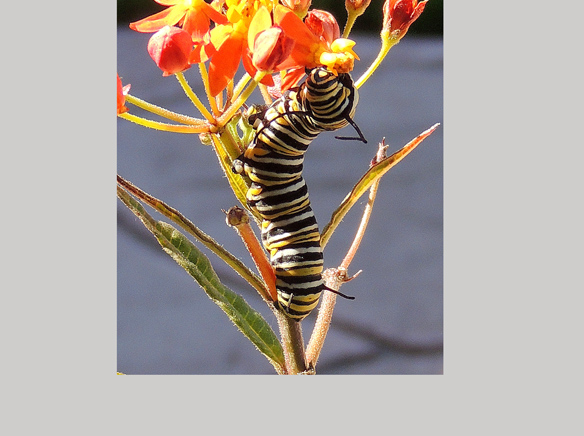El Cajon resident Sue Slaughter has a mission in mind. She wants to educate as many people as she can about the beauty and purpose of monarch butterflies. It all started when she purchased a monarch chrysalis at a nature event just a few years ago.
At first she thought the chrysalis was dead because nothing happened for a week. Then all of a sudden it started changing colors.
El Cajon resident Sue Slaughter has a mission in mind. She wants to educate as many people as she can about the beauty and purpose of monarch butterflies. It all started when she purchased a monarch chrysalis at a nature event just a few years ago.
At first she thought the chrysalis was dead because nothing happened for a week. Then all of a sudden it started changing colors.
But when she was able to see the orange, black and white butterfly inside the chrysalis, she sat down to look more closely. The chrysalis suddenly cracked open and the butterfly emerged, slowly, carefully, and then it hung upside down to dry its wings before its first flight.
It was so beautiful, I cried. This was the beginning of my love affair with monarchs,” said Slaughter, who calls herself “Susie Monarch.”
Monarch butterflies use milkweed as their host plants. Females will lay their eggs under the leaves of the plant. The first milkweed that Slaughter bought already had eggs on it, so she brought it inside for protection from predators. The eggs hatched; tiny caterpillars began eating the leaves and flowers of the plant. Slaughter spent hours watching their eating, crawling of and onto the plant, and cohabitating with each other.
“Hard to believe they have personalities, but they do. They bump each other off stems, butt heads, hang on the end of stems and twirl around,” she said.
Because they were inside, Slaughter was able to see the daily transformation of the caterpillar, or “cats” as she calls them. At the cats’ final stage, it forms a chrysalis, and within ten days, a butterfly emerges.
“Nature at her best and something everyone should witness in their lifetime,” Slaughter said.
At the How to Raise Monarch Butterflies class that she taught at Foothills Adult Center about a month ago, she taught the students how to experience their own monarch miracles.
“You can go as easy as you want or completely obsessed like I am,” she said, laughing.
When one of the students asked how much time exactly she spent devoting to the care of monarchs, she said “A lot! The dishes and laundry sometimes wait,” she said.
But monarchs can do well without a lot of human intervention. “If you raise them outside, nature takes over and you can do as little or as much as you like. Milkweeds are low maintenance, and they’re easy to grow,” she said.
Usually only 2 to 3 % of the eggs make it to the butterfly stage, so Slaughter chose to raise some inside, just to increase the number.
For this time of the year, the best thing that new or beginning monarch “parents” can do is to plant milkweed. Seeds take a little longer to germinate, so plants would jumpstart the project.
One thing to watch out for is over-watering, Slaughter said. If the leaves turn yellow, decrease the water. If the leaves continue to droop in the afternoon, more water is needed.
Monarchs are worth spending a little time and money in helping them grow, not just for their beauty, but also for the environment. They are great pollinators, drinking from milkweed as well as coneflowers, marigolds, zinnias, cosmos and many more flowers.
If they do make it from egg to caterpillar to butterfly, monarchs live a fascinating life. They migrate from the pine trees in the hills of Michoacán, Mexico, leave their overwintering sites there and then travel north and east. But San Diego monarchs don’t come from the hills deep in Mexico, but Arizona, Baja and the South Sierra mountains. They migrate to the coast of California in the winter.
Like so many other winged creatures, monarchs are threatened. As the world warms, habitat moves northward, causing longer migrations for the butterflies. At some point, monarchs may be forced to produce another generation to reach further north, and few may be able to make the longer trip back to Mexico or California for the winter.
In early March 2016, about 1.5 million monarchs died as a cold front hit the hills of Michoacán. Some had already left their migration and were headed north, but others were getting ready to leave when the freeze hit. The extent of
the loss is not yet known. Since our monarchs do not come from Michoacán, our
population should not be affected.
It’s easy to start raising monarchs, Slaughter said. Buy pesticide-free milkweed and plant it in a pesticide and herbicide-free part of the yard. Water it when it droops. If the temperature stays above 15 degrees F. it should survive over the winter.
“If you plant it, they will come,” Slaughter said.
For additional tips on raising monarchs, Slaughter recommends online websites, such as www.TexasButterflyRanch.com. The staff at the Water Conservation Garden and Cuyamaca College Nursery are also helpful. “They are friendly and have been most informative, especially with milkweed questions,” she said.
The next “How to Raise Monarch Butterflies” Class that Slaughter will be offered on July 23, 2016 during Super Saturday at the Foothills Adult Center.
The class that she taught in March filled up quickly and had to be closed, so it is advised to register for the class early. Register at www.adultschool.guhsd.net.














